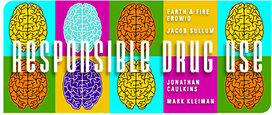“For the purposes of our primary thesis about the importance of accurate information and our hypothesis that more robust education about psychoactives can lead to more responsibility over time,” the Erowids write, “drug control policies are moot.” I agree with pretty much everything the Erowids say regarding the importance of accurate information, but I think they underplay the ways in which drug control policies foster misinformation and impede honest discussion of the risks and benefits of drug use. They themselves note that a state policy against teaching students younger than 21 about responsible drinking obstructs harm-reducing education. That policy can be understood only in the context of the current drinking age and the official expectation that people will not touch a drop of alcohol until they turn 21, at which point they will magically know how to drink responsibly.
In the case of illegal drugs, official resistance to a responsible-use message is even stronger. And because the government is committed to defending the lines it currently draws between licit and illicit, it is driven to disseminate propaganda that grossly exaggerates the dangers of illegal intoxicants. The climate of opinion fostered by this propaganda is hardly conducive to a candid discussion about psychoactive substances.
Or consider how drug policy affects beliefs about narcotic painkillers, which are legally situated between alcohol and marijuana. For decades pain experts have complained that “opiophobia” impedes the appropriate use of these drugs. The exaggerated fear of narcotics underlies current policies, and current policies reinforce that fear. When doctors worry that the government is looking over their shoulders every time they decide whether to prescribe a narcotic, how much to prescribe, and for how long, they are naturally less inclined to use these drugs, and surveys suggest they internalize the message communicated by the official scrutiny, greatly overestimating the risk of addiction in pain patients.
So while drug policy does not affect the wisdom of the Erowids’ clear-eyed, scientifically informed approach to psychoactive substances, it does affect the likelihood that their recommendations will be carried out. By the same token, however, encouraging people to follow this approach could lay the ground for drug policy reform (even if that is not the Erowids’ intention).
As far as drug education in schools goes, the arguments resemble those about sex education (although the former debate is at a less advanced stage, with school districts still overwhelmingly preferring a DARE-style approach). While some say complete abstinence is the only acceptable choice and therefore the only option that should be discussed, other say large numbers of teenagers will be engaging in the prohibited activity regardless of what their parents and teachers say, and they should be equipped with information to minimize the dangers of doing so. I am sympathetic to the latter view, and I wonder what Mark and Jonathan think. Is there such a thing as excessively honest drug education? Does conceding the possibility of responsible drug use, or even distinguishing between more and less dangerous kinds of drug use, encourage teenagers who otherwise would be abstinent to drink or use illegal drugs?

